A miracle is a feeling created by something strange and wonderful. It happens when you see or feel something rare and unexpected. They are reminiscent of the human capacity for discord, destruction, and possibly adornment.
The Seven Wonders of the Ancient World, simply known as the Seven Wonders, is a list of remarkable constructions from classical antiquity. Various authors wrote about these ancient wonders in the poems and guidebooks. The seven wonders were praised for their remarkable features, ranging from the highest of the highest or greatest of their kind, to the artistry with which they were executed. Their architectural and artistic features were imitated throughout the Hellenistic world and beyond.
A significant number of adventurers traveled to the actual sites to personally witness the wonders. Legends circulated to further complement the superlatives of the miracle.
The construction of seven of the most magnificent architectural and artistic human achievements continued beyond ancient Greek times to the Roman Empire. The Middle Ages, the Renaissance and into modern times.
The Seven Wonders of the Ancient World is a list of very important buildings a great Greek historian named Herodotus wrote over two thousand years ago. There are seven because he only wrote about the biggest structures he knew. He did not know much about Asia and America. Although there are several wonders in the world, there are seven that are recognized as ancient.
The Great Pyramids of Egypt
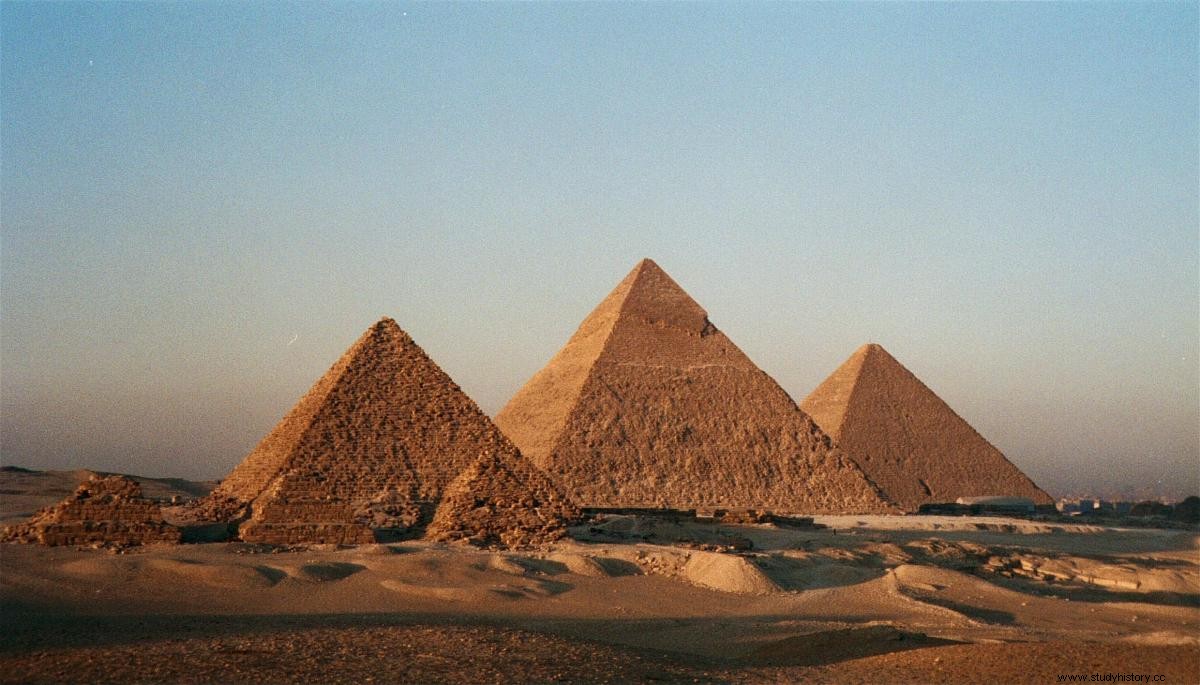
Built at a time when Egypt was one of the richest and most powerful civilizations in the world. The pyramids provide an insight into the country's rich and glorious past for 4000 years.
The pyramids, especially the great pyramids of Giza, are some of the most magnificent man-made structures in history. These pyramids were built from the beginning of the Ancient Empire to the end of the Ptolemaic period in the fourth century AD. The peak of pyramid construction began with the late third dynasty and continued until about the sixth (ca. 2325 BC). Until now, the Egyptian pyramids have retained much of their majesty.
The Great Pyramid is located in Giza on the west bank of the Nile, north of Cairo in Egypt. It is the only wonder in the ancient world that has survived to this day. It is part of a group of three pyramids - Khufu (Cheops), Khafra (Chephren) and Menkaura (Mycerimus). These were built between 2700 and 2500 BC. as a royal tomb. The largest and most impressive is Khufu, known as the "Great Pyramid," which covers 13 acres and is believed to contain more than 2 million boulders weighing from two to 30 tons each.
The larger sizes of these pyramids symbolize the powers that were assigned to the pharaohs, the power and success of their land.
The Hanging Gardens of Babylon
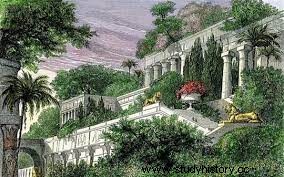
They are also known as Semirami's Hanging Gardens. It was built by Nebuchadnezzar II in 200 BCE, to please his beloved wife Semiramis. The king is said to have built the towering gardens to ease his lover's homesickness due to the natural beauty of her home in Media, the northwestern part of present - day Iran. It is said to have been built in the ancient city of Babylon, near present-day Hillah, the province of Babil, in Iraq. According to a legend, Hanging Gardens was built together with a magnificent palace known as The Marvel of Mankind.
The garden was said to have been planted as high as 75 feet in the air on a large square brick terrace that was laid out in steps like a theater. Modern scientists have extracted that in order for the gardens to survive, they would have had to be watered with a system consisting of a pump, water wheels and cisterns to transport water from the Euphrates many meters into the air.
It is still not clear whether Hanging Gardens was an actual construction or a poetic creation. There is no proper evidence that it exists. To date, no archaeological evidence has been found in Babylon for the hanging gardens. It is possible that there is evidence under the Euphrates, which at the moment can not be excavated safely.
The most detailed descriptions of the gardens come from Greek historians. There is no mention of them in ancient Babylonian records.
Statue of Zeus in Olympia
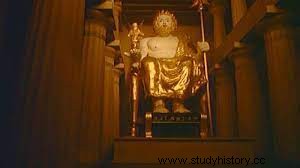
The statue of Zeus in Olympia was a giant seated figure made by the Greek sculptor Phidias around 435 BC. at the Shrine of Olympia, Greece. It was about 12.4 m high, located in the temple of Zeus.
The statue, completed by the classical sculptor Phidias around 432 BC, sat on a jeweled wooden throne inside a temple overlooking the city. Held a scepter in one hand and a small statue of the goddess of victory, Nike, in the other - both made of ivory and precious metals. Zeus sat on a painted tree in cedar, decorated with ebony, ivory, gold and precious stones. The statue of Zeus was commissioned by the Eleanors, supervisors of the Olympics, in the latter half of the fifth century BC. for their newly built Temple of Zeus.
In 391 AD banned the Christian Roman emperor Theodosius I from participating in pagan cults and closed the temples. The temple was closed when the Olympics were banned as a pagan practice in 391 AD, after Christianity became the official religion of the Roman Empire. The sanctuary of Olympia was unused. The circumstances surrounding the possible destruction of the state are unknown. The Byzantine historian Georgios Kedrenos from the 11th century records a tradition that it was carried on to Constantinople. There it was destroyed in the great fire of the Palace of Lausus, in 475 AD
The statue was eventually destroyed, although historians discuss whether it perished with the temple or was moved to Constantinople (now Istanbul) in Turkey and burned in a fire.
The Mausoleum of Halicarnassus in Turkey
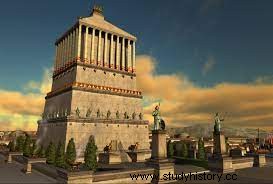
The famous tomb at Halicarnassus, now the city of Bodrum, was built between 370 and 350 BC. It was built for King Mausolus of Caria, in a region southwest of modern Turkey. Some historians say that the king's grieving wife Artemisia II had the tomb built as a memorial to their love. Mausolus was a satrap or governor of the Persian Empire, and his legendary tomb is the source of the word "mausoleum."
Due to its beauty and specialty, it became one of the seven ancient wonders. The tomb was erected on a hill overlooking the city. The whole structure sat in an enclosed courtyard. In the middle of the courtyard was a stone platform on which the tomb sat. In the middle of the platform, the marble tomb rose like a square tapering block to a third of the mausoleum's 45 m height. At every corner, stone warriors mounted on horseback guarded the tomb.
At the top of this part of the tomb are thirty-six slender pillars. There is a statue between each pair of pillars. Pyramidal consists of one third of the height of the ceiling. And behind the pillars was a solid cell-like block that carried the weight of the grave's massive roof.
Mausolus began planning the tomb before his death, as part of the construction work on Halicarnassus, so that when he died, Artemisia continued the construction project.
The structure was designed by the Greek architects Satyros and Pythius of Priene. The mausoleum was about 45 m high, and the four sides were adorned with sculptural reliefs, each made by one of four Greek sculptors:Leochares, Bryaxis, Scopas of Paros and Timotheus
It is unknown exactly when and how the mausoleum was destroyed:Eustathius, who wrote in the 12th century about his comment on the Iliad, says "it was and is a miracle". Because of this, Fergusson concluded that the building was destroyed, probably by an earthquake, between this period and 1402, when the Knights of St. John of Jerusalem arrived and registered that it was in ruins.
Temple of Artemis at Ephesus
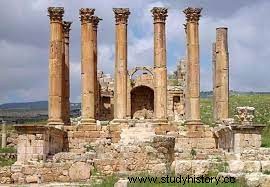
Temple of Artemis or Artemision is also known less precisely as Temple of Diana. It was located in Ephesus (near the modern city of Selçuk today Turkey)
There was actually more than one Temple of Artemis:a series of several altars and temples were destroyed and then restored in the same place. The most fabulous of these structures were two marble temples built around 550 BC, respectively. and 350 BC. It was completely rebuilt twice, once after a devastating flood and three hundred years later after an arson, and in its final form was one of the Seven Wonders of the Ancient World. In 401 AD had it been destroyed or ruined. Only the foundations and fragments of the last temple remain.
The original Temple of Artemis was designed by the Cretan architect Chersiphron and his son Metagenes and decorated by some of the most famous artists of the ancient world. The building burned down July 21, 356 BC. According to legend, the same night that Alexander the Great was born. The Ephesians financed the last form of the temple.
The temple was largely destroyed by Ostrogoth in 262 AD, and it was not until the 1860s that archaeologists excavated the first of the ruins of the temple's pillars at the bottom of the Cayster River.
The Colossus of Rhodes in Greece
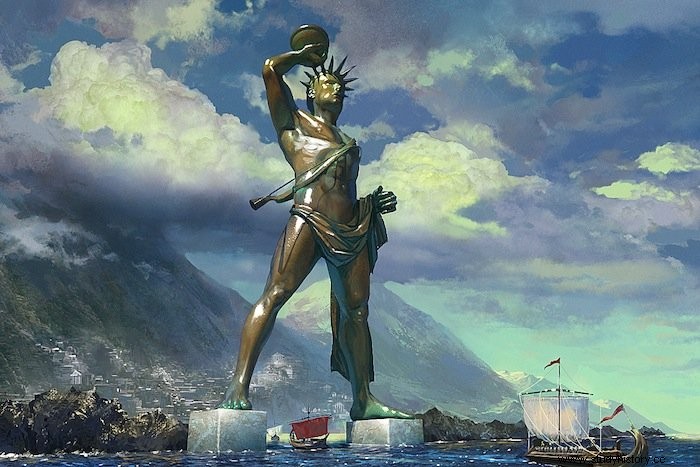
The colossus of Rhodes was a statue of the Greek sun god Helios. An enormous bronze sculpture of the sun god Helios was built by the Rhodians over 12 years in the third century BC. The sculptor Chares designed the statue. With a height of 100 feet, it was the tallest sculpture in the ancient world. Around 280 BC. it was completed and an earthquake struck it after 60 years. Hundreds of years later, the Arabs invaded Rhodes and sold the remains of the statue as scrap metal.
It was once thought that the statue stood with one leg on each side of a harbor, but most scientists now agree that the statue was most likely built close together to support the enormous weight.
No one rebuilt it. This is why archaeologists do not know much about the exact location of the state or what it looked like. It was erected to celebrate the unification of the island's three city-states, which successfully withstood a long siege of Antigonids in Macedonia.
Lighthouse in Alexandria, Egypt
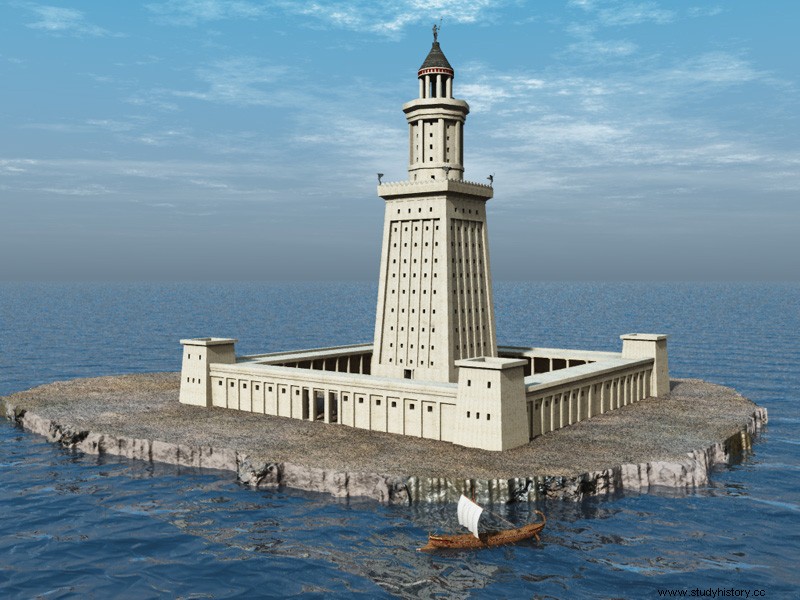
The lighthouse in Alexandria was located on a small island called Pharos near the city of Alexandria. It is sometimes called the Pharos of Alexandria, a lighthouse built by the Ptolemaic Kingdom in 280-247 BC. The height of the lighthouse has varied from 200 to 600 feet. Most modern scientists believe that it was about 380 feet high. For many centuries it was one of the tallest man - made structures in the world.
Between 956 and 1323, several earthquakes damaged the lighthouse, leaving an abandoned ruin. It was the third longest surviving ancient wonder (after the Mausoleum of Halicarnassus and the existing Great Pyramid of Giza), which partially survived until 1480, when the last remnants of the stones were used to build the Citadel of Qaitbay on the site.
In 1994, a team of French archaeologists dived into the waters of Alexandria's eastern harbor and discovered some remains of the lighthouse on the seabed. In 2016, Egypt's Ministry of Antiquities planned to turn the sunken ruins of ancient Alexandria, including Pharos, into an underwater museum.
the conclusion
Fire destroyed the Temple of Artemis and the statue of Zeus, while earthquakes destroyed the lighthouse of Alexandria, the Colossus and the tomb of Mausolus. Among the surviving objects are sculptures from the tomb of Mausolus and the Temple of Artemis, currently housed in the British Museum in London.
Today, only one of the original wonders exists, which are the Great Pyramids. They also serve as tourist destinations. Many people all over the world come to Egypt in large numbers just to see this great wonder.
These wonders are the cultural heritage of the people of the modern world. They put the spotlight on ancient history. Finally, we need them to find out their meaning and significance in the modern world. The ancient seven wonders should differ from the wonders of today to reveal the cause of their ancient times.
These legacies should not have been left behind before. These "Seven Wonders" present a hidden story behind or in their ruins, or in one case, within its remains.
